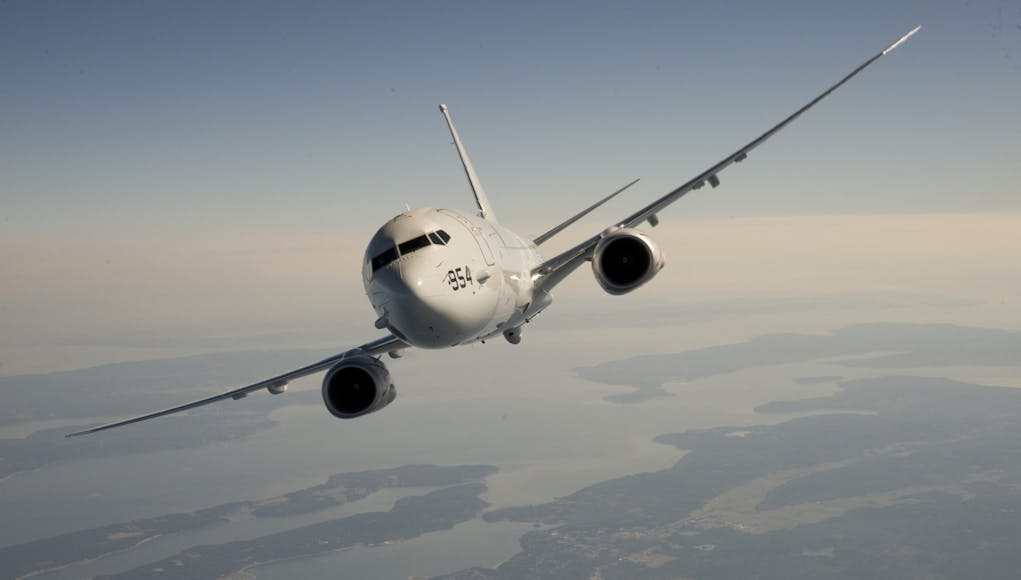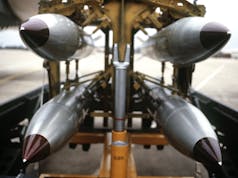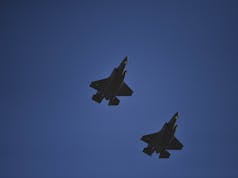The U.S. Navy received its 100th P-8A aircraft from Boeing as the global fleet, which also includes the Indian Navy and Royal Air Force, approaches 300,000 flight hours of hunting submarines and providing aerial reconnaissance capabilities around the world.
“We’re honored by the Navy’s faith and confidence in our employees and the P-8 system,” said Stu Voboril, vice president and program manager.
“Our focus has been, and will be, on delivering the world’s best maritime patrol aircraft, bar none.”
The P-8 is a long-range multi-mission maritime patrol aircraft capable of broad-area, maritime and coastal operations. A military derivative of the Boeing 737 Next-Generation aircraft.
Boeing say that this is the 94th mission-capable airplane to enter the U.S. Navy fleet, with six additional jets used as Engineering Manufacturing Development test aircraft. The 100th fully-operational delivery is scheduled for later this year.
Boeing has also delivered 12 jets to the Royal Australian Air Force, two to the Royal Air Force and eight P-8Is to the Indian Navy. Multiple U.S. Navy squadrons have deployed with the P-8A Poseidon, and the Indian Navy and Royal Australian Air Force are conducting missions with the P-8 as well.














“Out with the old and in with the new”. The USN’s mighty P3C subhunter is now in the history books.
https://www.navytimes.com/news/your-navy/2020/06/04/fair-winds-and-following-seas-to-the-navys-p-3c
Speaking of history… 76 years since D Day. How the world has changed since then. Makes you wonder if the few remaining veterans who took part view the sacrifices of that operation against the realities of today?
Cheers
Argentina seems to like them Old orions and the old worn out South Korean frigates…..
The Argentine defence budget rather limits their options along with their usual defence procurement dithering.
The P-3C and Ulsan class are a good fit for Argentina that has a huge exclusive economic area to patrol. This is actually to the benefit of the Falkland Islands as whilst neither will seriously alter the balance of power in the area they will allow the Argentine to try and stop illegal fishing in their waters which is a major problem in that part of the world. The squid don’t know about exclusive economic zones or borders.
The P-3C with upgrades are viable for many more years and the Ulsan class even stripped of its heavy armament is more than enough to over awe a Chinese Jigger illegally fishing in their waters, it also have a very handy 8000 nautical mile range at 16 knots which will be very useful in that role.
It’s a depressing thought. For the first time since then, “freedom” is in retreat globally.
Apparently some P3s’ will remain in use until 2023 with Reserve Units, and “Funnies”.
Also on the subject of old and new:
https://www.pilotonline.com/military/vp-nw-ford-truman-training-20200604-hjfqik5cljbpbm6qfnfjuxlvte-story.html
Cheers
Time to ramp up the RAF delivery and to order more to replace the ageing battlefield surveillance fleet which is to be replaced.
The RAF delivery is actually happening pretty quickly…just a couple of months until our third airframe arrives and the 2nd squadron standing up this year…agreed about more airframes though…always…more airframes
They still have the old Shackleton in mothballs ??
A REAL aircraft… Bring back the SHACK!
Uhhhhhh… Terribly sorry…. Got a little out of hand there…
Cheers
Where and how many……any port in a storm……
Speaking about more airframes or even old airframes the UK Government sometimes, no often get me confussed. I will start with the Tornado, we have scrapped ours yet Germany are carrying out an upgrade and will get at least another five years out of them. Then come Sentinel, aparantly it is to be withdrawn from service as it is becoming obsolete, yet the RAF say it is one of the most advanced systems in the world. Then comes the E3 Sentry being rapalced with the E7. So lets start with the E3, possibly in five years when they will be replaced could be used in the Caribbean on anti drug operations or in the Falklands. It is the same with Sentinel, again basing them in the Caribbean a very useful tool for intel gathering. It is possible that these two aircraft might no longer be suitable for front line peer to peer service but in anti drug operations. It is the same in many ways with the Tornado, used in the second line role for example again in the Caribbean armend with the older anti air and anti ship missiles it would give drug runners something to think about. Also in that region which country would have a better system apart from the US which is a close friend (sometimes). But no we will chop them up into bits and use our limited front line resources and stretch them thinly everywhere. I forgot to mention my pet fustration the Herc, they are being replaced and scrapped yet they could have been reused in the humanitarian role again leaving the front line transport aircraft to do there job.
Some might scream how is this to be paid for and who will man it, the Hercs would be paid for by the international aid budget and manned by them, they could be retired RAF flight crew. As for Sentinel and Sentry, I am not sure what budget is used for anti drug, anti piracy or anti trafficing patrols is used, possibly there is an international pot. However it is also international aid in some ways but I am sure that some smart person in government could figure this out. So the only real cost to the MoD would be say two squadrons of Tornados, all the others could be broken down into spare parts, as for pilots well RAF reserve pilots could man them for flight hours. Just think about five Sentry’s in the Caribbean able to call on a sqn of Tornados drug smugglers would have a really bad time.
Its only an idea on how to do something better without stretching our resources whilst getting the last useful life out of equipment that is no longer tier 1.
We got a lot more use out of our Tornados compared to Germany’s, mind.
Ours were pretty worn out, like a car owned by a travelling salesman who drives ip and down the country, vs Germany’s which are akin to a car that’s had one careful old lady driver who only uses it once a week to nip to Tesco.
But I do think we should have kept them going until 2025, which was the original plan. We would at least, by then, have 2 operational squadrons of F35.
That said, the fact we use our planes more is exactly why we should really have more of them. Using them as much as we do, theu wear out, whereas if we had more planes the wear and tear can be spread out. Our Typhoon fleet needs to last another 20 years but even if the MoD never sees another defence cut that number will only continue to dwindle in size as the years go on.
I agree we did get a lot more use out of them. What I was trying to highlight is just because something is not the latest piece of kit does not mean that it could not be used in a diffrent theatre. So for example the Tornados, do we really need a flight of Typhoons in the Falklands? At the moment no Argintina does not have any modern combat aircraft, so could a sqn of Tornados be based there, yes. Do we have enough E7 Wedgetail on order to have some based in the Caribbean or Falklands no, but would the E3 do the job for the next 10 years in the Caribbean, yes. Its the same with do we really need a T45 on anti drug or anti piracy patrol, no but if we had replaced the T23 ten years ago as they should have been would a T23 for the last ten years do a good job on anti drug anti piracy yes. We built ships in 1913 that ended service in 1946. We never have enough equipment, when we get new equipment it is normally ten years late, then orders are reduced making the cost higher reducing the numbers even more. Then we need to carry out all the same tasks with less equipment meaning that it needs to be repalced sooner. So in the end it becomes a never ending downward spiral.
We need to stop this by ordering equipment about ten years before it is expected to go out of service, then use the older equipment for tier 2 tier 3 theatres and the latest equipment for front line tier 1 situations.
The problem with the Herc’s was the main wing spars. The MoD thought it would be too expensive to replace, as its pretty much a new wing. It hasn’t stopped us selling them to Austria and Bangledesh. They got overhauled my Marshalls before delivery, with new wing spars! Admittedly they also had some structural repair around the ramp area.
It was the same with the Tornado. The main structural element is the wing box that house the swing wing mechanism. These were pretty worn and needed replacing. The rest of the aircraft could have kept going. But BAe were going charge a fortune for the wing boxes as it would need a new production run starting up. So the MoD went cheers, no thanks. It’s a shame that we couldn’t have kept the GR9s as even though they spent a lot of time in Afghan and on the odd boat. There airframes were in really good condition and still had a lot of life in them.
The Sentrys cannot get replaced soon enough. Their 707 airframes have had it and have a terrible availability. This is because a lot of the tertiary systems are obsolete and no longer manufactured. There is a lot of cannibalisation to get the aircraft serviceable.
I really get what you’re saying about having a reserve fleet. The problem we have is that our Airforce is quite small (in fact our whole armed forces vehicles and ships etc), so the few aircraft we do have get over-used. When they come for retirement from front line flying, they’re basically shagged and will cost too much to maintain. We already pay a shed load of money to keep obsolete parts in manufacture. It’s a pity we can’t lease hire and replace every 3 years.
We make this mistake every time and no one ever learns. Well, it’s not a mistake on the MoD’s part, or the forces’, both those parties are blameless in this, it’s the Treasury’s fault!
We were meant to get 232 Typhoons. Due to defence cuts this was reduced to 160 – with the remaining 72 sold to Saudi Arabia. Imagine if we’d been able to keep all those! The wear and tear on each individual airframe would be much less, not to mention we’d have another 2-3 squadrons of Typhoons.
Out of our 160 delivered we now have around 140, with the rest scrapped for parts to keep the rest going.
By the time Tempest enters service in 2035-40 we’ll be down to maybe 80-90 Typhoons and they’ll be knackered!
Pure fantasy I know but if MoD were to get a significant cash injection and it were up to me I’d order another 50-60 Typhoons, replace the olders ones and get the squadron numbers up.
I agree on the Treasury part. They only seem to see the short term benefits that smaller numbers brings. It may also be compounded by the MoD, saying we can still achieve our aims with these reduced numbers, not seeing the issues it causes long term. Because by then it will be someone elses problem!
I did see a long while back the Saudi Typhoons at Leeming being prepped before delivery. There was a number of RAF Typhoons opposite all on jacks. The techies were robbing the wheels and sticking them on the Saudi ones. It was a pure WTF moment. But speaking to one of them, they’d been told it had to be done to meet the contract conditions. They also said there were other parts being robbed to make sure the Saudi ones were ready.
I didn’t know that. Wow… just… wow! Absolutely shocking! That shows that HMG and MoD really don’t care about our defence. We should never, ever compromise our own forces just to quickly fulfil a sales contract.
Even if we had kept the 232 order but done an “over the life of the program” like with F35, we could have fulfilled the contract. The contract was for 72 Typhoons, that should have been done as new planes built for the sale by BAE, would have resulted in several billion in taxes for the economy, not to mention additional work meaning jobs are retained and employees spend the money here.
The focus on short term financial savings is toxic, perpetuated by MoD civil servants who only see their career path.